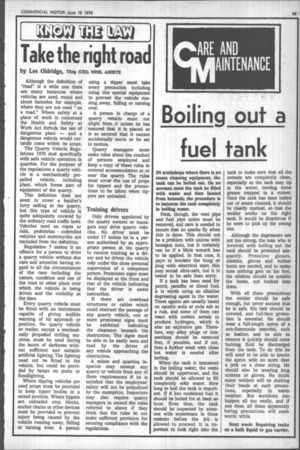ARE AND AINTENANCE
Page 101

If you've noticed an error in this article please click here to report it so we can fix it.
Boiling out a fuel tank
IN workshops where there is no steam cleaning equipment, the tank can be boiled out. On no account must the tank be filled with water and then heated from beneath; the procedure is to immerse the tank completely in boiling water.
First, though, the vent pipe and fuel pipe union must be removed, and care is needed to ensure that no sparks fly when this is done. This should not be a problem with unions with hexagon nuts, but it certainly can be if a Mole wrench has to be applied. In that case, it pays to insulate the bung or plug with electrical tape; this may sound ultra-safe, but it is better to be safe than sorry.
If a tank has been used for petrol, paraffin or diesel fuel, it is worth using an alkaline degreasing agent in the water. These agents are usually based on caustic soda or soda ash as a rule, and some of them can react with certain metals to produce hydrogen, which is also an explosive gas. Therefore, any alloy plugs or connections should be removed first, if possible, and if not, then a further wash with clean hot water is needed after boiling.
When the tank is immersed in the boiling water, the vents should be uppermost, and the tank should be allowed to fill completely with water. How long to boil the tank is important. If it has contained fuel it should be boiled for at least an hour. Even then, the tank should be inspected by someone with experience in these matters before the job is allowed to proceed. It is important to look right into the tank to make sure that all the corners are completely clean, especially as the tank may tip in the water, leaving some grease trapped in a corner. Once the tank has been boiled out or steam cleaned, it should be clearly marked, so that the welder works on the right tank. It would be disastrous if he were to pick up the wrong one.
Although the degreasers are not too strong, the man who is involved with boiling out the tank should be protected adequately. Protective glasses, oilskins, gloves and rubber boots are needed, and to make sure nothing gets on his feet, the oilskins should be outside the boots, not tucked into them.
With all these precautions the welder should be safe enough, but never assume that he is safe. His hair should be covered, and full-face protection is essential. He should wear a full-length apron of a non-flammable material, such as leather, and be able to remove it quickly should some burning fluid be discharged from the tank. To do this he will need to be able to loosen the apron with no more than a jerk on a draw string. He should also be wearing long mittens or gloves. No doubt many welders will be shaking their heads at such precautions, especially in warm weather. But accidents can happen all too easily, and if one does, all these apparently boring precautions will seem worth while.
Next week: Repairing tanks on a bulk liquid or gas carrier.












































































































































































